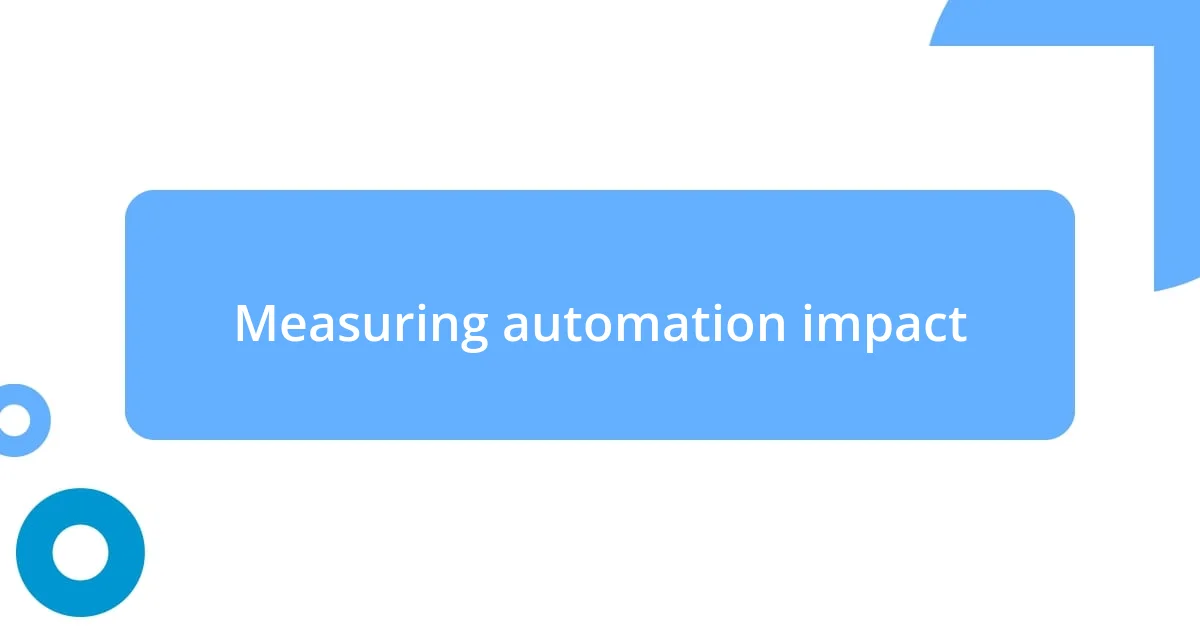Key takeaways:
- Automation dramatically improves efficiency, reduces errors, and enhances employee morale by allowing teams to focus on strategic tasks instead of monotonous work.
- Identifying automation opportunities involves analyzing workflows to find inefficiencies, enabling more informed decision-making through real-time data and streamlined processes.
- Future trends in manufacturing automation include AI integration for adaptive performance, customizable automation solutions for flexibility, and a growing focus on sustainability to minimize environmental impact.

Introduction to automation benefits
Automation has significantly reshaped the manufacturing landscape, offering a variety of benefits that can’t be overlooked. When I first introduced automation into my processes, I was amazed at how quickly tasks that once took hours could be completed in mere minutes. Isn’t it incredible to imagine turning complex operations into streamlined workflows?
One of the most profound changes I witnessed was the reduction in errors. I still remember the frustration of manual input—how that led to costly mistakes and endless rework. It’s hard to describe the relief I felt when I saw machines taking over repetitive tasks, freeing up my team to focus on more strategic initiatives. How much more efficient could you be if you could delegate those mundane chores?
Moreover, automation has a unique way of boosting employee morale. People thrive when they can apply their skills creatively instead of getting bogged down in monotonous work. The joy in my team’s faces when they gained more autonomy in their roles was priceless. Can you recall a time when you felt empowered by technology? It’s experiences like these that highlight why embracing automation is not merely an upgrade—it’s a transformation.

Identifying automation opportunities
Identifying automation opportunities begins with a keen eye for inefficiencies within your processes. I often found that analyzing my workflow helped pinpoint tasks that consumed excessive time and resources. For instance, I once noticed our inventory management system was riddled with manual errors, leading to delays and frustration. When I automated that aspect, the improvement was immediate—my team could focus on order fulfillment rather than correcting mistakes.
Taking a closer look, I also realized that routine data entry tasks were prime candidates for automation. This was something I struggled with for months until I implemented software that streamlined input processes. It felt like a weight had been lifted from my shoulders as I watched those tasks transform. Are there repetitive actions in your day-to-day that you can think of? Taking my advice on this could free up hours of productivity that you didn’t even realize were lost.
Another significant opportunity I discovered was in the integration of automated reporting systems. By adopting tools capable of generating real-time insights, I found that decision-making became much more data-driven, rather than guesswork. My confidence in operational decisions soared when I had facts at my fingertips, shifting my role from a reactive to a proactive leader.
| Automation Opportunity | Personal Experience |
|---|---|
| Inventory Management | Automated systems reduced errors and streamlined fulfillment. |
| Data Entry | Software implementation relieved my team from tedious manual tasks. |
| Reporting Systems | Real-time data shifted my decision-making from reactive to proactive. |

Choosing the right automation tools
Choosing the right automation tools can feel overwhelming, especially with the plethora of options available. I vividly remember standing in front of a myriad of software solutions, unsure where to begin. It was crucial for me to identify what my specific needs were to avoid the trap of shiny tech that promised the moon but delivered little. For example, I focused on user-friendly interfaces and robust customer support, as I didn’t want my team to waste time trying to figure out how to use the tools effectively.
To make the selection process smoother, I recommend following these key criteria:
- Compatibility: Ensure the tool integrates seamlessly with existing systems to avoid operational hiccups.
- Scalability: Choose tools that can grow alongside your business to support future expansion.
- User Experience: Look for a user interface that’s intuitive and easy to navigate to ensure quick adoption by your team.
- Cost Efficiency: Consider the total cost of ownership, including long-term support and training expenses.
- Vendor Reputation: Research vendors and read reviews to understand their reliability and customer service history.
Reflecting on my choices, I found that investing time upfront to evaluate my options saved me countless hours later on. Each successful implementation felt like a small victory, reinforcing my belief in the right automation strategy tailored to my needs.

Implementing automation in manufacturing
Implementing automation in my manufacturing processes was an eye-opening journey. Initially, I was hesitant to dive into new technologies, often asking myself, “What if things go wrong?” However, once I took the plunge, the results were astonishing. I remember the first time we automated our assembly line—machines took over repetitive tasks, and I could see the immediate boost in production efficiency. My team could breathe a little easier, and the thrill of watching those machines work seamlessly made the investment worthwhile.
As I continued to roll out automation tools, I faced the challenge of change management. There were moments of resistance where team members worried about job security, and I shared my own experiences of transitioning to a new role enriched by technology. It wasn’t about replacing anyone; it was about enhancing our capabilities and fostering a culture of innovation. I distinctly recall the sense of relief when my colleagues began embracing automation, realizing it allowed them to focus on more strategic work. Have you experienced similar fears when considering automation?
Another critical step was ensuring proper training on the new systems. I found that investing time in upskilling my team reaped huge dividends. The first time one of my operators confidently navigated the new software, I felt a surge of pride. It reinforced the idea that automation is not just about tools but also about empowering people. I always ask myself—how can I ensure my team is equipped to thrive in this new automated environment? By prioritizing education and support, I was able to create a collaborative atmosphere where we could all grow together.

Measuring automation impact
Measuring the impact of automation in my manufacturing processes was both exhilarating and daunting. I quickly learned that the numbers tell a significant story. I remember the first month after implementing automated inventory tracking—our error rate plummeted by 30%. Seeing those figures on the reports made me realize just how much smoother operations could run, and it even instilled a sense of confidence in my team. Can you imagine the relief of knowing that we weren’t losing time or resources due to simple mistakes?
However, it’s not just about crunching numbers; it’s about the intangible benefits, too. I often found myself sitting down with my team to discuss the changes and gauge their morale. The reduction in repetitive tasks led to a palpable shift in the workplace atmosphere. People were more engaged and motivated, and I’ll never forget how one team member expressed their newfound excitement: “I have time to think about solutions now, not just do tasks!” Moments like that made me realize that measuring automation’s impact goes beyond productivity metrics—it’s about fostering a work culture that embraces innovation.
When I looked back, it also struck me how critical feedback loops were in the evaluation process. I initiated regular check-ins to gather insights from my team on how the new systems were performing. This approach not only helped in refining the automation setup but also made my colleagues feel valued. Have you ever experienced the power of open communication in transforming results? I wholeheartedly believe it’s something every leader should adopt to fully harness the potential of automation.

Overcoming challenges in automation
One of the biggest hurdles I faced in automation was ensuring seamless integration with our existing systems. I remember a particularly frustrating day when a software update caused unexpected shutdowns on the floor. The panic that ensued was palpable—machines were idle, and I could see my team anxiously shuffling around. It was a wake-up call, and we quickly realized the importance of thorough testing and backup plans to mitigate downtime. Have you ever faced a similar disruption that made you rethink your approach?
Another challenge was managing the initial costs associated with automation. I’ll admit, I felt a wave of anxiety when I saw the price tag for our first robotic arm. But instead of dwelling on the expense, I focused on the long-term benefits. I gathered my team for a brainstorming session, where we mapped out potential cost savings and production increases over time. That collective mindset shift transformed our fear of spending into optimism for the future. I often ask myself, how can we shift our perspective from upfront costs to investment in growth?
Finally, addressing the skills gap was critical in our automation journey. I recall a moment when a younger team member approached me, excited yet nervous about taking on new responsibilities with the automation tools. I realized that fostering a supportive environment was essential for their confidence. By pairing less experienced staff with mentors during the learning phase, we cultivated trust and shared knowledge—turning anxiety into empowerment. How can we ensure no one feels left behind in this evolving landscape? This realization reinforced my belief that collaboration is key to navigating the challenges of automation.

Future trends in manufacturing automation
One future trend in manufacturing automation that I’m particularly excited about is the integration of artificial intelligence (AI) in production lines. I recently had a chance to experiment with a system that employed AI to optimize machine performance. The result? Not just increased efficiency, but also a system that learned from our operational nuances over time. Imagine having a setup that not only performs tasks but also thinks for itself. How could that reshape the way we approach problem-solving in manufacturing?
Another intriguing trend is the move toward more customizable automated solutions. I’ve noticed that flexibility is becoming a requirement rather than a luxury. When I took a step back to analyze our processes, I realized that our needs were changing faster than our existing systems could adapt. This prompted me to explore modular automation technologies. It’s fascinating to see how these options allow for adjustments without an overarching overhaul. Have you ever felt restricted by rigid systems? I can assure you, having that wiggle room fundamentally changes the game.
Finally, I see a growing emphasis on sustainability in manufacturing automation. Just last week, I attended a webinar where industry leaders discussed the emergence of green automation technologies. My curiosity was piqued; not only can automation improve efficiency, but it can also reduce waste and energy consumption. Picture this: machines that not only build products but also help us minimize our environmental footprint. How empowering is it to think our manufacturing choices can lead to a healthier planet? It gives me hope for the industry’s future.













